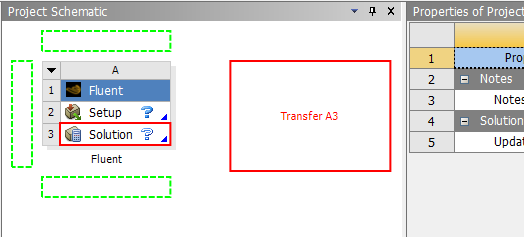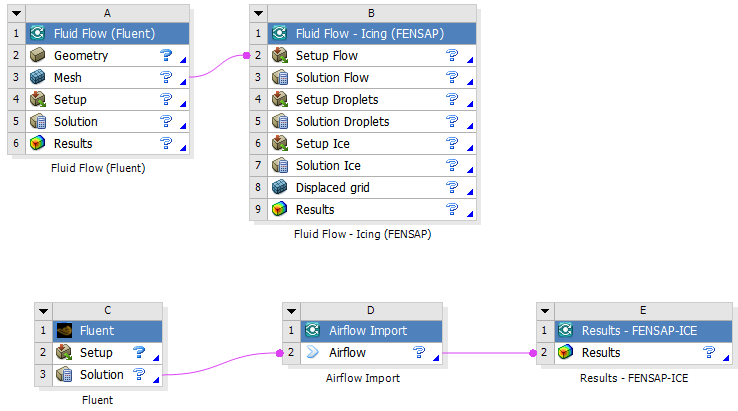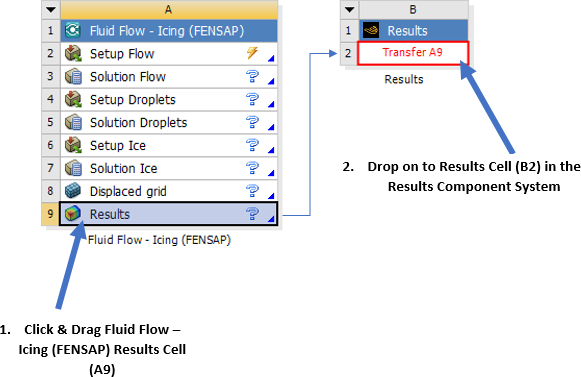In Workbench, you can create connections between multiple systems that enable those specific systems to access the same data. This is useful, for instance, when you want to compare the results from multiple FENSAP-ICE based systems in the same Ansys CFD-Post session. In this case, you would connect the various Results cells to one Results cell (either in one of your FENSAP-ICE based systems or in a separate Results system). When you double-click that Results cell, the results from all connected systems will be loaded into Ansys CFD-Post at the same time.
Workbench supports two different types of connections:
Shared data connections
Used when the inputs and outputs of the two connected cells are identical.
Can only be created between two cells of the same type.
A shared data connection is represented in the Project Schematic by a line with a square on its right (target) side
 (see Figure 2.2: Connected Systems Within Workbench Project Schematic ).
(see Figure 2.2: Connected Systems Within Workbench Project Schematic ).
A shared data connection is represented in the Project Schematic by a line with a square on its right (target) side (see Figure 2.2: Connected Systems Within Workbench Project Schematic ).
Transfer data connections
Used when the output of one cell is used as the input to the connected cell.
Usually created between two cells of different types. One exception is that a transfer data connection can be used between the Solution (Flow/Droplets/Ice) cells of two FENSAP-ICE based systems when you want to use the current data from one system as the initial data for the other system. A transfer data connection is represented in the Project Schematic by a line with a circle on its right (target) side
 (see Figure 2.2: Connected Systems Within Workbench Project Schematic ).
(see Figure 2.2: Connected Systems Within Workbench Project Schematic ).
Important: Currently, the transfer data connection option is limited in its functionality with FENSAP-ICE based systems. See Ansys, Inc. Release Notes for more details.
There are four ways to create connected systems in Workbench.
Click a cell in one system, then drag and drop it onto a compatible cell in another system.
Click a system in the Toolbox, then drag and drop it onto a compatible system in the Project Schematic.
Create a duplicate system (see Duplicating FENSAP-ICE Based Systems).
Right-click a cell and select one of the options under Transfer Data From New... or Transfer Data To New... (these options are not available for all cells). Transferring data from the Solution (Flow/Droplet/Ice) cell to a new FENSAP-ICE based system’s Setup (Flow/Droplet/Ice) cell transfers the mesh (but not the settings) to the Setup (Flow/Droplet/Ice) cell.
Caution: The Transfer Data From New... or Transfer Data To New... options are supported for FENSAP-ICE based systems, but should be used with caution, as some options may not function correctly or provide the correct workflow.
When you click and hold down the mouse button on a system in the Toolbox, Workbench highlights all of the compatible drop targets in the Project Schematic. As you move the mouse over a drop target, it is highlighted in red and a message appears in the Project Schematic that informs you what the result will be if you drop the system onto that target.
There are usually several compatible drop targets on empty space in the Project Schematic. Dropping the system onto one of these targets will create a standalone system in that location.
Similarly, when you highlight a cell and begin to drag it, Workbench highlights all of the compatible drop targets in the Project Schematic. As you move the mouse over a drop target, it is highlighted in red and a message appears in the Project Schematic that informs you what the result will be if you drop the cell onto that target.
For more information about connecting systems, see Creating Connected Systems, as well as the following sections:
Connecting an Upstream Mesh to Multiple Setup Cells of FENSAP-ICE Systems
Connecting Systems by Dragging and Dropping a System from the Toolbox onto Another System
You can connect a Mesh/Model cell of a Mesh/ICEM CFD component system to multiple Setup Flow cells of FENSAP-ICE based systems in conjunction with a Mesh Import component system. The mesh data, including the mesh input parameters that you may have defined in the Ansys Meshing/ICEM CFD application, will then be transferred to the Setup Flow cell. When you start FENSAP from the Setup Flow cell, FENSAP will read the mesh data from the connected Mesh/Model cells (via the Mesh Import component system).
Important: The Mesh/Model cell connection of a Mesh/ICEM CFD component system to a Setup Flow cell (via Mesh Import component system) of a FENSAP-ICE based system must output Fluent mesh file types (*.msh. This will allow the Mesh Import component system to convert the file into a FENSAP format grid file (*.grid) which could then be read by the Setup Flow cell of the FENSAP-ICE based system.
The following example demonstrates the procedure for creating connected systems by dragging a system from the Toolbox and dropping it onto a compatible system in the Project Schematic (See Figure 2.3: Applying the Fluent Solution Data to a New Fluent-ICE Based Analysis System by Dragging and Dropping Systems).
Figure 2.3: Applying the Fluent Solution Data to a New Fluent-ICE Based Analysis System by Dragging and Dropping Systems

Starting from a project with an up-to-date Fluent component system, select the Fluid Flow – Icing (Fluent) analysis system from the Toolbox; the compatible drop targets are highlighted in green.
Drag the system over the Project Schematic and pause over the Solution cell of the Fluent component system; the Solution cell target is highlighted in red and a message informs you that selecting that target will transfer the data from cell A3 to the new system.
Drop the system on the drop target and a transfer data connection is created between the Solution cell A3 and the Airflow cell B2.
Note: Solution cell A3 becomes Update Required, this is because the input data for the new system has not yet been generated by the Ansys Fluent solver.
Right-click Solution cell A3 and select Update to run the Fluent calculation.
Right-click Airflow cell B1 and select Update to convert the Fluent case and data files to FENSAP-ICE format input files.
The next example demonstrates the procedure for creating connected systems by dragging a Results system from the Toolbox and dropping it onto a FENSAP-ICE based analysis system in the Project Schematic (See Figure 2.4: Applying the Results Component System to a New FENSAP-ICE Based Analysis System by Dragging and Dropping Systems).
Figure 2.4: Applying the Results Component System to a New FENSAP-ICE Based Analysis System by Dragging and Dropping Systems

Starting from a project with an up-to-date FENSAP-ICE analysis system, select the Results component system from the Toolbox; the compatible drop targets are highlighted in green.
Drag the system over the Project Schematic and pause over the Results cell of the FENSAP-ICE analysis system; the Results cell target is highlighted in red and a message informs you that selecting that target will transfer the data from cell A9 to the new system.
Drop the system on the drop target and a transfer data connection is created between the Results cell A9 and the Results cell B2.
Note: Results cell A9 becomes Update Required, this is because the input data for the new system has not yet been generated.
Right-click Solution cell A9 and select Update to run the update the cell.
Right-click Results cell B2 and select Update to convert the FENSAP-ICE format files to *.cgns format input files for Ansys CFD-Post.
In the previous two examples, transfer data connections types were created.
Shared data connections can also be creating by dragging a system from the Toolbox and dropping it onto a compatible system in the Project Schematic. The type of connection that Workbench creates depends on which drop target you select. The red preview messages in the Project Schematic inform you of the type of connection(s) that will result from your action.
Currently, FENSAP-ICE based systems do not support shared data connections. See Ansys, Inc. Release Notes for more details.
The following figures demonstrate the procedure for creating a transfer data connection by dragging a Results cell from a FENSAP-ICE analysis system and dropping it onto a compatible cell in another system:






